Comic Book Confidential
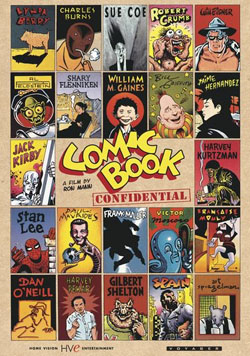 I have always been a fan of comic books. Since I was a toddler and before I could read I was huge fan and would often get comics of Superman, Batman, Spider-Man, and The Hulk. I have covered my comic book collecting days on these very web pages of this site with Comic Book Craze Part 1 and Part 2. This Growing Up Fanboy, I will be writing about a documentary that covers the history of comics and it is a film that I have been a fan of for years and is one of my favorite documentaries of all time. The film that I am refereeing to is Ron Mann’s Comic Book Confidential.
I have always been a fan of comic books. Since I was a toddler and before I could read I was huge fan and would often get comics of Superman, Batman, Spider-Man, and The Hulk. I have covered my comic book collecting days on these very web pages of this site with Comic Book Craze Part 1 and Part 2. This Growing Up Fanboy, I will be writing about a documentary that covers the history of comics and it is a film that I have been a fan of for years and is one of my favorite documentaries of all time. The film that I am refereeing to is Ron Mann’s Comic Book Confidential.
I first discovered this doc back in the summer of 1990. I happened to see an advertisement for it on Cinemax and looked up when it was going to be airing. Back then I would tape almost every movie, TV show, or music video that was on TV that I liked and had a massive collection of VHS tapes. Comic Book Confidential was one of those films that I recorded and would often watch over the years. It is an excellent documentary that chronicles the history of comic books from their birth in the 1930’s up until the late 80’s.
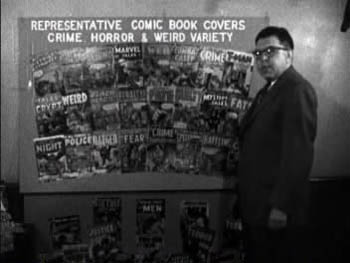
Groups start cracking down on comics, which started the Comics Code.
Comic Book Confidential was released in 1988 in Canada and later released in the U.S. in 1989. Fellow Canadian documentary filmmaker Ron Mann directed it. The film starts off with an excerpt from a 1950’s program or PSA called Confidential File, which warned people about comics and how they were not suitable for young children. This was during the time right before The Comics Code was adapted. The scene has a man talking to the camera and describes a violent scene in one of EC’s horror comics. I have always liked this opening and it sets the tone of the movie by giving it a touch of nostalgia.
The documentary features interviews from comic book artists past and present and starts off with how it all began. There’s an interview with William M. Gaines from EC Comics, talking about how his father started comic books by taking the Sunday funnies, folding it up, putting a 10 cent sticker on it, put it on newsstands and sold them. He called the first comic book Famous Funnies. Pretty soon there was original material in comic books instead of recycled comic strips. The biggest impact on comics was the birth of Superman, which started the super hero craze. Batman, Wonder Woman and others followed suit.
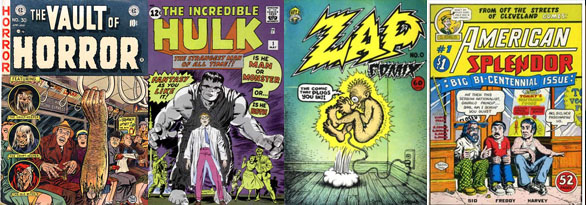 The film’s first interviews are with some iconic figures like Jack Kirby who created Captain America for Timely Comics (later known as Marvel Comics). Captain America was prefect during the World War II era where he fought the evils of the world. Will Eisner’s The Sprit was more of a pulp comic then a super hero one, but it fit into that time as well. Eisner talked about how it was a great time for comics and a great time to be an artist and a part of that history.
The film’s first interviews are with some iconic figures like Jack Kirby who created Captain America for Timely Comics (later known as Marvel Comics). Captain America was prefect during the World War II era where he fought the evils of the world. Will Eisner’s The Sprit was more of a pulp comic then a super hero one, but it fit into that time as well. Eisner talked about how it was a great time for comics and a great time to be an artist and a part of that history.
Once the war ended super heroes started to dwindle a bit and they were more kiddy or romance comics out there. Then the 1950’s came and William M. Gaines and Al Feldstein of EC Comics started up a bunch of horror comics which included Tales from the Crypt, Vault of Horror, and Haunt of Fear just to name a few. These comics were very popular with kids, teens, and adults. The horror stories in these comics were nothing anyone had ever read or seen. Then the comics came under attack for being too violent and gory. Spear headed by Dr. Fredric Wertham and parent groups, comic books went on trial and had senate meetings on what to do about them. The documentary features more scenes from Confidential File demonstrating how comics were bad for children and shows a dramatization where one little boy pick up a rock while reading comics in the woods with his friends, and has an evil look on his face like he is about to strike one of his friends with the rock. This backlash resulted in the formation of The Comics Code, which censored many comics and was the downfall to all horror comics from EC.
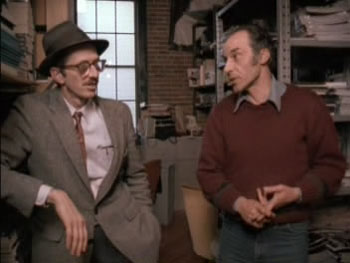
Godfathers of Underground Comics, Robert Crumb and Victor Moscoso
EC then tried their hands at humor and had Harvey Kurtzman create a humor magazine called MAD. MAD was the first of its kind where it was the first spoof comic that had its own twist on current events and pop culture. Then during the 60’s Timely Comics became Marvel and created some of the most classic super hero comics by Stan Lee. Super heroes were popular again and were geared toward the modern age. Super heroes like Spider-Man, Hulk, The Fantastic Four, and many others flooded the newsstands for kids of all ages. The doc has a great montage animation featuring the Marvel super heroes and playing the song The Marvel Super Heroes have Arrived. It is one of the best parts in the film.
The documentary then explores the underground comics of the 60’s starting with Robert Crumb’s work. The underground comics were not code friendly and lived by their own rules and expressed themselves with their beliefs and drew what they wanted. Crumb who was living in Cleveland at the time, moved to San Francisco where other underground artists were and created comics such as Zap Comix, Mr. Natural, and Fritz the Cat. Other underground artists around that time that the film interviewed were Victor Moscoso, who also worked on Zap Comix, Spain who did Trashman, and Gilbert Shelton who did The Fabulous Furry Freak Brothers. Another artist featured is Dan O’Neill who made Air Pirates which is a parody of Mickey and Minnie Mouse. O’Neill got into some big legal trouble for the parody because he had a scene in the comic of Mickey and Minnie having sex.
During the 70’s and 80’s other artists and comics started popping up and many were women. The world of comics did not have that many women artist or writers and the comics that were for girls, men mostly wrote. The film talked to some key women that wanted to express themselves through the art of comics. They talked to Shary Flenniken who did Trots and Bonnie, Lynda Barry of Girls and Boys, Francoise Mouly who worked on RAW magazine, and Sue Coe who did How to Commit Suicide in South Africa.
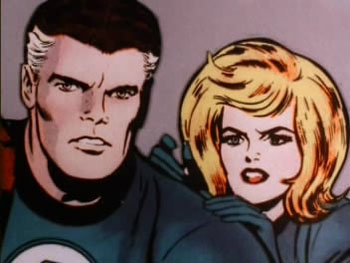
Marvel's Fantastic Four
The film discussed other underground artists and independent companies. Artists like, Bill Griffith who brought us the goofy comic, Zippy, Jaime Hernandez who did Love and Rockets, and Harvey Pekar who gave us American Splendor. Like Crumb, Pekar was also from Cleveland and started his comic in the 70’s, which was a day in the life of Pekar himself. Crumb actually did the art on some of the earlier issues. I first heard of Pekar when I saw him on Late Night with David Letterman back in 1987. He was mostly on show for laughs because of his oddball behavior, but I remember them also mentioning his comic. I still have to get my hands on an issue of American Splendor.
They also interviewed some other artists like Art Spiegelman who also worked on RAW magazine and did Maus which was a graphic novel that told the story of the Holocaust, but the Jews were portrayed as mice and the Nazis were cats. Charles Burns who also worked on RAW had his own modern day horror comic called Big Baby, which was less like the classic EC comics and more real life horror.
The movie concludes with a montage showcasing specialty comic book stores and talking about super heroes in the late 80’s. There is an interview with Frank Miller talking about his new graphic novel (at the time) The Dark Knight and how he portrays Batman like he was in the 30’s where he is more ruthless and feared and not the way he became over the years where he was geared towards kids.
Overall the documentary is excellent and like I mentioned before is one of my favorite documentaries and a must see for any comic book fan. Some key moments throughout the film were the sequences where they took a panel of a comic from an artist they were interviewing and had their voice as they read part of the comic while the film showed different panels. This was very creative and included music and sound effects as well. The overall music in the doc was great which featured many classic songs from mostley the 30’s, 40’s, and 50’s. The music also fit well when they showed many of the montages and stock footage that they used throughout the film. Another thing that stuck out is when they were interviewing Dan O’Neill and he is playing pool and has a few scantily clad women there playing the game. It was just funny seeing this goofy looking guy with these hot women.
Comic Book Confidential is an excellent documentary that captures the history of comic books. If you always wanted to find out how comics started then check out this film. Since first seeing this documentary in 1990 it got me interested in watching other documentaries. This was the first documentary that I really watched and was very impressed by it. I have many great memories of this film and I still enjoy watching it today.
